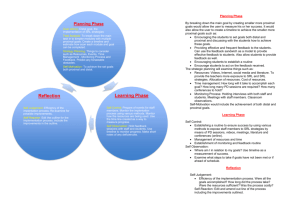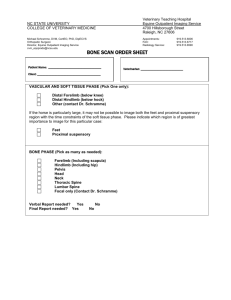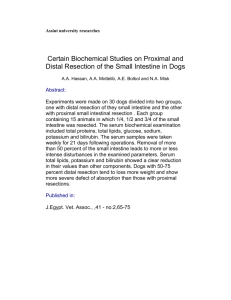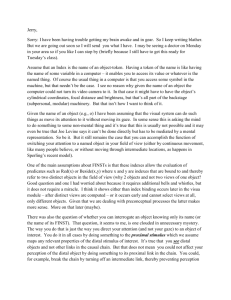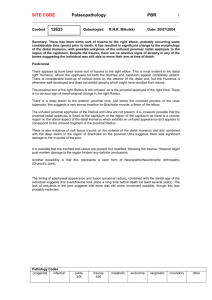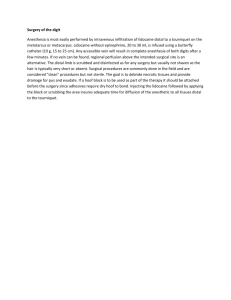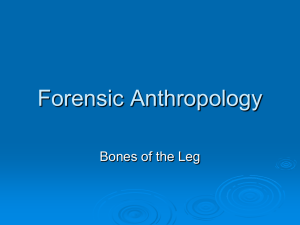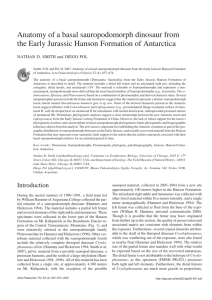A HIND LIMB OF THERIZINOSAURUS
advertisement
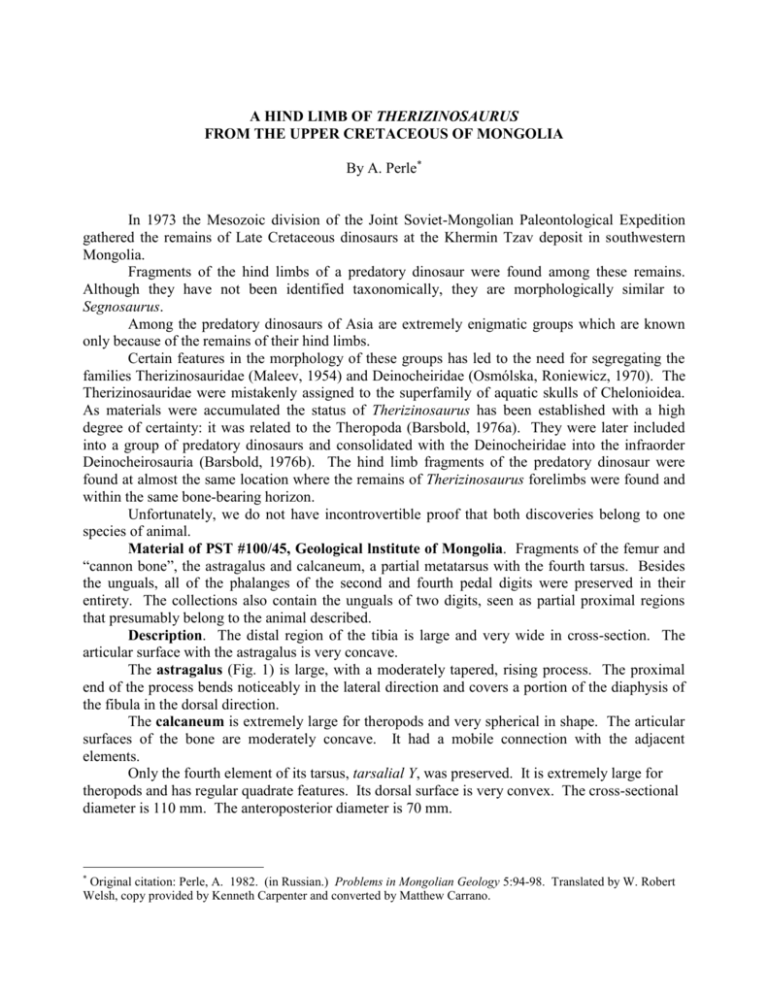
A HIND LIMB OF THERIZINOSAURUS FROM THE UPPER CRETACEOUS OF MONGOLIA By A. Perle* In 1973 the Mesozoic division of the Joint Soviet-Mongolian Paleontological Expedition gathered the remains of Late Cretaceous dinosaurs at the Khermin Tzav deposit in southwestern Mongolia. Fragments of the hind limbs of a predatory dinosaur were found among these remains. Although they have not been identified taxonomically, they are morphologically similar to Segnosaurus. Among the predatory dinosaurs of Asia are extremely enigmatic groups which are known only because of the remains of their hind limbs. Certain features in the morphology of these groups has led to the need for segregating the families Therizinosauridae (Maleev, 1954) and Deinocheiridae (Osmólska, Roniewicz, 1970). The Therizinosauridae were mistakenly assigned to the superfamily of aquatic skulls of Chelonioidea. As materials were accumulated the status of Therizinosaurus has been established with a high degree of certainty: it was related to the Theropoda (Barsbold, 1976a). They were later included into a group of predatory dinosaurs and consolidated with the Deinocheiridae into the infraorder Deinocheirosauria (Barsbold, 1976b). The hind limb fragments of the predatory dinosaur were found at almost the same location where the remains of Therizinosaurus forelimbs were found and within the same bone-bearing horizon. Unfortunately, we do not have incontrovertible proof that both discoveries belong to one species of animal. Material of PST #100/45, Geological lnstitute of Mongolia. Fragments of the femur and “cannon bone”, the astragalus and calcaneum, a partial metatarsus with the fourth tarsus. Besides the unguals, all of the phalanges of the second and fourth pedal digits were preserved in their entirety. The collections also contain the unguals of two digits, seen as partial proximal regions that presumably belong to the animal described. Description. The distal region of the tibia is large and very wide in cross-section. The articular surface with the astragalus is very concave. The astragalus (Fig. 1) is large, with a moderately tapered, rising process. The proximal end of the process bends noticeably in the lateral direction and covers a portion of the diaphysis of the fibula in the dorsal direction. The calcaneum is extremely large for theropods and very spherical in shape. The articular surfaces of the bone are moderately concave. It had a mobile connection with the adjacent elements. Only the fourth element of its tarsus, tarsalial Y, was preserved. It is extremely large for theropods and has regular quadrate features. Its dorsal surface is very convex. The cross-sectional diameter is 110 mm. The anteroposterior diameter is 70 mm. * Original citation: Perle, A. 1982. (in Russian.) Problems in Mongolian Geology 5:94-98. Translated by W. Robert Welsh, copy provided by Kenneth Carpenter and converted by Matthew Carrano. The metatarsus comprises four elements that are unusually short for theropods. They are large with moderately separated epiphyses. Other than the first metatarsus, they are closely adjoined to one another by the diaphyses in the proximal region. The first metatarsal is noticeably deflected away from the second, but its proximal region greatly restricts the second metatarsal laterally. The proximal region of the second metatarsal’s diaphysis is larger than that of the others. The distal articular condyles are only slightly developed. The lateral ligamentous cavities are slightly separated. Maximum length is 200 mm. The third element of the metatarsus is short relative to the others. The diaphysis of the bone is smaller than the second. The ventral surface of the diaphysis’ distal region has a very deep cavity. Maximum length is 250 mm. The fourth metatarsal is known only from its proximal region. The diaphysis of the bone is almost equal in size to that of the third metatarsal. The proximal articular surface of the fourth metatarsal is almost totally overlapped by the tarsal element tarsalia distale. The phalanges of the digits give the probable phalangeal formula: I-2, II-3, III-4, IV-5. The first digit is the shortest relative to the other three. But it cannot be compared with that of theropods, it is strong and provides support. The basal phalanges are large, symmetrical in construction and, with the exception of the phalanges of the first digit, are very flat in the dorsoventral direction. The phalanx of the first digit is higher. The lateral ligamentous cavities are moderately defined. The epiphyses are well isolated. Maximum length of the basal phalanges in the second digit is 85 mm and 70 mm in the fourth digit. The middle phalanx II of the second digit is somewhat longer than the basal, narrower and noticeably high. Its distal articular region is very well proportioned. The lateral ligamentous cavity is well defined. On the whole, the body of the phalanx is somewhat curved medially, particularly in the proximal region. Maximum length is 95 mm. The two middle phalanges of the fourth digit, i.e. III and IV, the F-sesamoidal, are extremely short. Phalanx III is 30 mm long, and phalanx IV is 33 mm. The pre-unguals are comparatively long, well proportioned, and narrow in the distal region. The aforementioned narrowness in the distal region of the pre-unguals explicitly corresponds to the large flat areas on the pre-unguals. In this connection, the fragments of the proximal region of the unguals contained in the collections stimulate our interest. At first glance they seem to be very flat for claws of predatory dinosaurs, but the aforementioned features in the pre-ungual (a narrow interepiphyseal cavity and high articular surface area) show that it is even possible that the unguals in these large theropods are unusually laterally compressed. Commentary. By examining the possible taxonomy of the dinosaur discovered at Khermin Tzav, we hypothesize that the Therizinosauridae, Deinocheiridae, and Segnosauridae; i.e. all carnosaurs with hypertrophied development of the forelimbs, are a single taxonomic group. Segnosaurus is the earliest representative of this group and was found in the Bayn Shire deposit. Therizinosaurus and Deinocheirus came from the Nemegt, i.e. from the same horizon in which the material described here was found. A number of features have been noted in the morphology of the Khermin Tzav dinosaur that demonstrate its similarity to Segnosaurus. These are the extreme shortness of the metatarsal elements in comparison with those of other theropods, the larger number of metatarsals that provide support (four), and short sesamoidal phalanges on the fourth pedal digit. The morphology in the scapulocoracoid region indicates that Segnosaurus is very similar to Therizinosaurus, but smaller in size. The scapular ramus is approximately the same length in both forms and they are the same size. The tubercle for the attachment of M. coracobrachialis is more highly developed in Therizinosaurus than in ordinary theropods. Nevertheless, it is much less than in Segnosaurus. The rather specific topography of the superglenoid enlargement in Segnosaurus is the same as seen in Therizinosaurus. The deltopectoral crest of the humerus was more highly developed in Therizinosaurus and Segnosaurus and, respectively, the flexors M. coracobrachialis and M. humero-radialis were stronger. This probably says that the forelimbs of Segnosaurus were more curved at the elbow than in other theropods. These features are practically nonexistent in Deinocheiridae, which apparently makes it taxonomically independent at the familial level from Therizinosaurus and Segnosaurus. Here the morphological commonality in the structure of the limbs, specific only for this group, is preserved. At the same time, the significant lateral compression of the pedal unguals we have described clearly shows that this limb cannot belong to the segnosaurids. From the hypothesis we have laid out, that the Khermin Tzav dinosaur was a contemporary of Therizinosaurus, and the almost coincident deposit of its remains with those of Therizinosaurus forelimbs, we believe it reasonable to assume that this foot belonged to Therizinosaurus. LITERATURE CITED R. Barsbold, “Evolution and classification of Late Cretaceous predatory dinosaurs” in: Joint Soviet-Mongolian Paleontological Expedition, Paleontology and Biostratigraphy of Mongolia (in Russian) Nauka, Moscow (1976) pp. 68-75. R. Barsbold, “New data on Therizinosaurus (Therizinosauridae, Theropoda)” in: Joint Soviet-Mongolian Paleontological Expedition, Paleontology and Biostratigraphy of Mongolia (in Russian) Nauka, Moscow (1976) pp. 76-92. E. A. Maleev, “A new turtle-like lizard in Mongolia”, Priroda, No. 3, pp. 106-108 (1954). A. Perle, “Segnosauridae, a new family of Theropoda from the Upper Cretaceous of Mongolia” in: Joint SovietMongolian Paleontological Expedition, Vol. 8, (in Russian) Nauka, Moscow (1976). H. Osmólska and E. Roniewicz, “Deinocheiridae, a new family of theropod dinosaurs” in: Results Polish-Mongol. Palaeontol. Exped., II - Palaeontol. Polonica, No. 21, pp. 5-99 (1970). Figure Caption Fig. 1. Specimen No. 100/45. Distal regions of the “cannon bone” and foot. (a) from the dorsal side; (b) distal bones of the astragalus, calcaneum and tibia from the ventral side; (c) metatarsal elements from the proximal side. Mongolia, southwest Gobi, Nemegt Formation, Upper Cretaceous.
